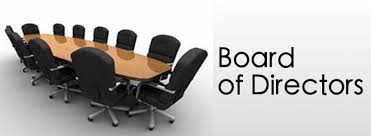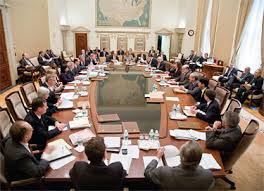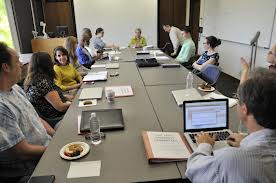 Bright eyed and bushy-tailed. I love those two descriptions because they perfect describe most newly minted non-profit executive directors. They are eager, optimistic, and ready to change the world when they walk through your agency’s door on their first day of work.
Bright eyed and bushy-tailed. I love those two descriptions because they perfect describe most newly minted non-profit executive directors. They are eager, optimistic, and ready to change the world when they walk through your agency’s door on their first day of work.
It is at this point that I’ve witnessed many exhausted board volunteers collapse because the first day for the new executive director typically represents the end of a long executive search process. Of course, the reality is that the first 90 days are perhaps some of the most crucial days for the new executive director and the organization.
As I reflect back upon my experience 14-years ago, I now recognize how lucky I was to have been hired by an agency that belonged to a larger national organization (e.g. Boys & Girls Clubs of America). The board simply pointed me in the direction of the regional office, and they signed me up for “New Executive Orientation”. There were pre-training worksheets that walked me through an assortment of activities geared toward hitting the ground running.
But what if your agency doesn’t belong to a national organization? What should your new executive director’s first 90 days look like?
Without getting into a very tactical answer to this question, here are a few big picture activities both the board and the new executive director should look at engaging in:
- The board needs to develop a written (and measurable) 90 day performance management plan for the new CEO
- At the end of the first 90 days, the board needs to evaluate their new employee against the written performance management plan and issue another written management plan focused on the remainder of the year
- The new exec should schedule one-on-one meetings with every board member to talk about the following: 1) where do they currently see the agency and 2) in what direction do they think the agency should be moving
- The new CEO should be meeting in-person with the agency’s top 25 or top 50 donors to get their perspective on where the agency is and where it should be going
- The new executive director should meet in-person with each of the agency’s key stakeholders and collaborative partners
- Back home at the office there is much to do including: 1) reviewing all grants (esp grant deliverables), contracts, audits, recent financial statements, and written organization plan and policy documents including bylaws and 2) getting to know operational staff and learning programs
- The board needs to plan a party and introduce their new executive director to the community
 Exhausted yet?
Exhausted yet?
Well, these six bullet points are only meant to be a big picture view.
If you are looking for something more tactical and detailed, I ran across a great document online from NAMI titled “The First 90 Days: The New NAMI Executive Director’s Guide“. I think this is a great resource to help new executive directors hit the ground running. It is definitely worth the click. 😉
What has your agency done to help its new executive director hit the ground running? Please use the comment box below and share your thoughts and opinions. Why? Because we can all learn from each other.
Here’s to your health!
Erik Anderson
Founder & President, The Healthy Non-Profit LLC
www.thehealthynonprofit.com
erik@thehealthynonprofit.com
http://twitter.com/#!/eanderson847
http://www.facebook.com/eanderson847
http://www.linkedin.com/in/erikanderson847

 The two questions I get asked on a regular basis are “What is the right number of board members?” and “How often should our board meet?” The answer to both is the same: whatever it takes. You should have the number of board members you need who meet as often as necessary to get the job done.
The two questions I get asked on a regular basis are “What is the right number of board members?” and “How often should our board meet?” The answer to both is the same: whatever it takes. You should have the number of board members you need who meet as often as necessary to get the job done. There has been some movement in recent years toward boards meeting less often with committee meetings in between. Some boards meet every other month. Some boards (mine obviously) meet monthly and their committees do as well. Some boards meet quarterly.
There has been some movement in recent years toward boards meeting less often with committee meetings in between. Some boards meet every other month. Some boards (mine obviously) meet monthly and their committees do as well. Some boards meet quarterly. Still, as I stated at the beginning, only you can decide what the best model is for your organization. I offer some questions for you as you consider the right number of meetings:
Still, as I stated at the beginning, only you can decide what the best model is for your organization. I offer some questions for you as you consider the right number of meetings: Again, only you can decide what the best model is for your organization. I offer some questions as you consider the right number of members:
Again, only you can decide what the best model is for your organization. I offer some questions as you consider the right number of members:
 My community had a paltry 10% of eligible voters turn out to vote on Election Day. My neighbor said that any vote that didn’t have at least 40% of the eligible voters voting should be thrown out. But, of course and for good reason, it doesn’t work like that. Elections – and most other things – are decided by those who show up.
My community had a paltry 10% of eligible voters turn out to vote on Election Day. My neighbor said that any vote that didn’t have at least 40% of the eligible voters voting should be thrown out. But, of course and for good reason, it doesn’t work like that. Elections – and most other things – are decided by those who show up. Appointed or elected community leaders govern an organization. As outlined in my favorite Board book
Appointed or elected community leaders govern an organization. As outlined in my favorite Board book  The Finance Committee, chaired by Treasurer, works with the appropriate staff in examining the financial reports, understanding and monitoring the financial condition of the organization and preparing the annual budget. The Treasurer presents the monthly financial statements to the Board at each board meeting. This committee also selects an audit firm each year and reviews the audit plan, audit and 990, which should be signed by the Treasurer prior to submission.
The Finance Committee, chaired by Treasurer, works with the appropriate staff in examining the financial reports, understanding and monitoring the financial condition of the organization and preparing the annual budget. The Treasurer presents the monthly financial statements to the Board at each board meeting. This committee also selects an audit firm each year and reviews the audit plan, audit and 990, which should be signed by the Treasurer prior to submission. I recommend caution when creating committees to do the work of staff. It gets very confusing as to who is responsible for what and responsible to whom. If Board members are acting in staff roles, the Executive Director retains the authority for decision-making. If the Board members are operating within the scope of their roles, the Board has the authority for decision-making. Conversations had in advance can help you avoid role confusion and the overstepping of boundaries.
I recommend caution when creating committees to do the work of staff. It gets very confusing as to who is responsible for what and responsible to whom. If Board members are acting in staff roles, the Executive Director retains the authority for decision-making. If the Board members are operating within the scope of their roles, the Board has the authority for decision-making. Conversations had in advance can help you avoid role confusion and the overstepping of boundaries. As someone with two degrees in planning, I catch myself all the time with my non-profit clients explaining that the solution to their problems is that they need a plan. It might be a strategic plan, resource development plan, or board development plan . . . but oftentimes I am amazed at how many times failing non-profit agencies just haven’t invested in creating plans. I mean, come on folks! Who hasn’t heard the old expression, “If you fail to plan, then you plan to fail“?
As someone with two degrees in planning, I catch myself all the time with my non-profit clients explaining that the solution to their problems is that they need a plan. It might be a strategic plan, resource development plan, or board development plan . . . but oftentimes I am amazed at how many times failing non-profit agencies just haven’t invested in creating plans. I mean, come on folks! Who hasn’t heard the old expression, “If you fail to plan, then you plan to fail“? As I’m sure you aware by now, I like to reflect back on things that have occurred and create a plan to avoid their reoccurrence. As such, I’ve been thinking about things our field can do to be stronger.
As I’m sure you aware by now, I like to reflect back on things that have occurred and create a plan to avoid their reoccurrence. As such, I’ve been thinking about things our field can do to be stronger. Over the last few months, I’ve found myself doing a lot of boardroom trainings on the subject of “Board Roles & Responsibilities“. When facilitating this training, there are two different slides talking about the board’s collective responsibilities and the other illustrates individual board members’ responsibilities. Listed on both slides at the top of the list is the responsibility of “asking questions“.
Over the last few months, I’ve found myself doing a lot of boardroom trainings on the subject of “Board Roles & Responsibilities“. When facilitating this training, there are two different slides talking about the board’s collective responsibilities and the other illustrates individual board members’ responsibilities. Listed on both slides at the top of the list is the responsibility of “asking questions“. Of course, we aren’t talking about asking questions that lend themselves to micro-management of staff. Here are just a few important questions that good boards ask:
Of course, we aren’t talking about asking questions that lend themselves to micro-management of staff. Here are just a few important questions that good boards ask: I tried to picture what a non-profit board might look like if it didn’t ask questions, and these words all came to mind:
I tried to picture what a non-profit board might look like if it didn’t ask questions, and these words all came to mind: On Tuesday evening I found myself sitting in front of a group of board volunteers as well as prospects who were contemplating joining the board. What started off as a routine training about basic board roles and responsibilities morphed into a discussion about what makes an exceptional board.
On Tuesday evening I found myself sitting in front of a group of board volunteers as well as prospects who were contemplating joining the board. What started off as a routine training about basic board roles and responsibilities morphed into a discussion about what makes an exceptional board. I cannot tell you the number of people over the course of my 20 years in non-profits that either congratulated me for running my non-profit like a business and went on to tell me non-profits should be run like a business. I never knew what to say. Thank you?
I cannot tell you the number of people over the course of my 20 years in non-profits that either congratulated me for running my non-profit like a business and went on to tell me non-profits should be run like a business. I never knew what to say. Thank you? Non-profits have to manage the budget AND meet the mission.
Non-profits have to manage the budget AND meet the mission. Non-profits are not run by one person for a reason. The Board represents the community as the owners of the organization. The organization exists to meet a need. Businesses, which also address needs, exist to make money.
Non-profits are not run by one person for a reason. The Board represents the community as the owners of the organization. The organization exists to meet a need. Businesses, which also address needs, exist to make money. “I regard it in fact as the great advantage of the mathematical technique that it allows us to describe, by means of algebraic equations, the general character of a pattern even where we are ignorant of the numerical values which will determine its particular manifestation.”
“I regard it in fact as the great advantage of the mathematical technique that it allows us to describe, by means of algebraic equations, the general character of a pattern even where we are ignorant of the numerical values which will determine its particular manifestation.” (I feel compelled to counter a possible negative perception of this last point by noting that isn’t it a very good thing if a manager sees when an associate or team is struggling, and at the right time and in the right way enters the picture and provides just the right amount of help to get back on the right track? Less freedom is not always a bad thing!)
(I feel compelled to counter a possible negative perception of this last point by noting that isn’t it a very good thing if a manager sees when an associate or team is struggling, and at the right time and in the right way enters the picture and provides just the right amount of help to get back on the right track? Less freedom is not always a bad thing!) I look forward to seeing the ones that you’ve run across!
I look forward to seeing the ones that you’ve run across!